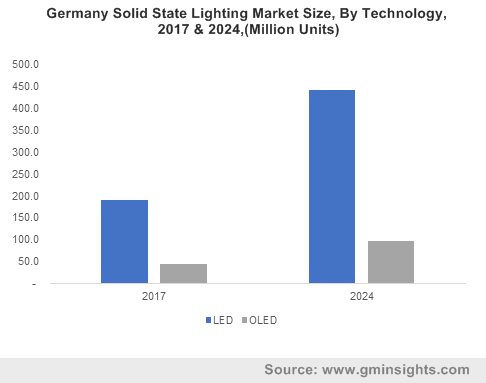North America solid-state lighting market to register a double-digit CAGR of 11.5% over 2018-2024, U.S. to be a major revenue pocket
Publisher : Fractovia | Published Date : 2018-08-22Request Sample
Worldwide expansion of the solid-state lighting market at an extraordinary pace has resulted in the development of more efficient and impactful lighting solutions, suitable for numerous indoor and outdoor applications. Regardless of whether it is used for residential, industrial, commercial or automotive purposes, SSL technology ensures lower energy consumption and enhanced lifespan for products like high lights, auto lamps, panel indicators, signals and signages. Rapid advancement in LED technology has given additional momentum to the solid-state lighting industry, by allowing improved brightness and flexibility required for producing big screens as well as small size lightings. solid state lighting generally consists of semiconductors, and remarkable innovations in the semiconductor manufacturing industry have certainly influenced the growth of the global solid-state lighting market, valued at over USD 34.5 billion in 2017.
U.S. Solid State Lighting Market Size, By Technology, 2017 & 2024, (Million Units)

The adoption of solid-state lighting technology has penetrated a slew of industry verticals, including the automotive segment where the demand of LED lamps and indicators has been rising exponentially. Manufacturers and consumers are gaining awareness regarding the benefit of SSL-based LED solutions in replacing halogen lamps. LED lamps are also ideal for retrofit vehicle exterior or interior lights and are increasingly being deployed in luxury, sports, as well as some off-road vehicles. The automobile industry is slated to contribute enormously towards the solid-state lighting market, with lamps that offer greater visibility and utilize lower amounts of energy. Statistics indicate that by 2024, the total production of vehicles in North America could surpass 20 million and the U.S. could be expected to lead the regional growth, as 2018 predictions alone show a potential sale of up to 16.7 million light trucks and new cars in the country.
Consequently, an increase in the use of LED lightings for vehicle turn indicators, cockpit and glove box lights, fog lights and other applications will bolster the LED-based solid-state lighting market, anticipated to cross USD 85 billion in revenues by 2024. The ability to provide high brightness using lower voltages has made solid-state lighting LED lights appropriate for being fitted in electric vehicles that are completely run on Li-ion batteries. Not surprisingly, the advent of e-vehicles over the next few years will further transform the solid-state lighting industry to align with requirements of vehicle efficiency standards and development of new functionalities. Additionally, government regulations that outline green-building standards and energy saving guidelines promote the installation of cost-saving lightings for industrial and public infrastructure, inadvertently fueling the augmentation of the solid state lighting market.
LED lights are aptly suited to be used in street lights and other high-cost maintenance systems since they have a longer life expectancy. The Omaha Public Power District (OPPD), in the U.S. state of Nebraska, comprises of 13 counties and serves over 352,000 consumers in Omaha. Reportedly, OPPD has undertaken huge initiatives to replace nearly 100,000 sodium street lights, with highly-efficient LED over the next five years. Through this change, cities will save 25 to 30% in payments made to OPPD for street lighting and the new lights will provide better visibility for motorist and pedestrians. These lights are said to have a lifespan of 20 years where as the sodium lightings worked for only 5 years.
Similar undertakings in other parts of the region will generate tremendous income for the solid-state lighting industry in the U.S., supported by the rising number of SSL component producers and infrastructure development activities. Industrial consumers that need to pay thousands of dollars in electricity bills every month, value the efficiency of solid-state lighting fixtures in reducing overall utility charges. Higher color rendering index assures the presence of the best possible light for different surroundings and combined with growing affordability of LED lights, the solid-state lighting market will experience a robust growth from lighting retrofits in the residential and commercial segments. For instance, Tri-State LED, a comprehensive lighting and control solutions provider, is currently working on a lighting retrofit program for the equity firm Brookwood.
To elaborate, began in 2016, the large scale retrofitting operation involves replacing existing lights with efficient LED alternatives at 94 office buildings held by Brookwood, spread across different cities in the U.S. The buildings in total span approx. 7.3 million square foot and present a huge opportunity to implement solid-state lighting solutions. Brookwood has estimated that the program could help reduce the energy consumption of light fixtures by more than 65%, all building combined. As evident, the solid state lighting industry provides a significant avenue for curtailing energy costs and improving bottom lines.
With the presence of leading semiconductor manufacturers that offer more efficient solid-state lighting components and the upsurge in spending towards infrastructure upgradation, North America is slated to witness a strong stance in the global landscape. Global Market Insights, Inc. forecasts the regional solid-state lighting market size to expand at a projected 11.5% CAGR over 2018-2024.